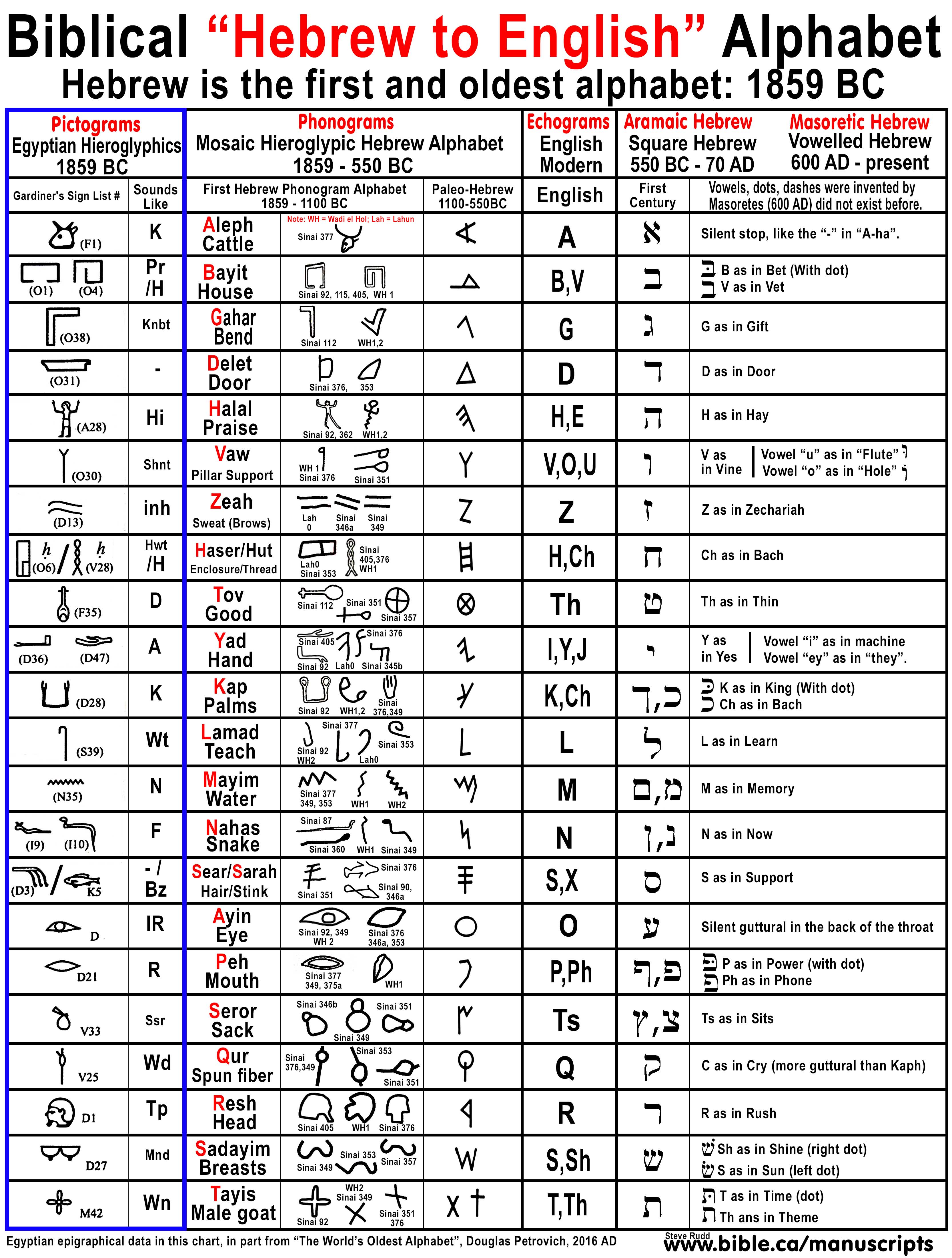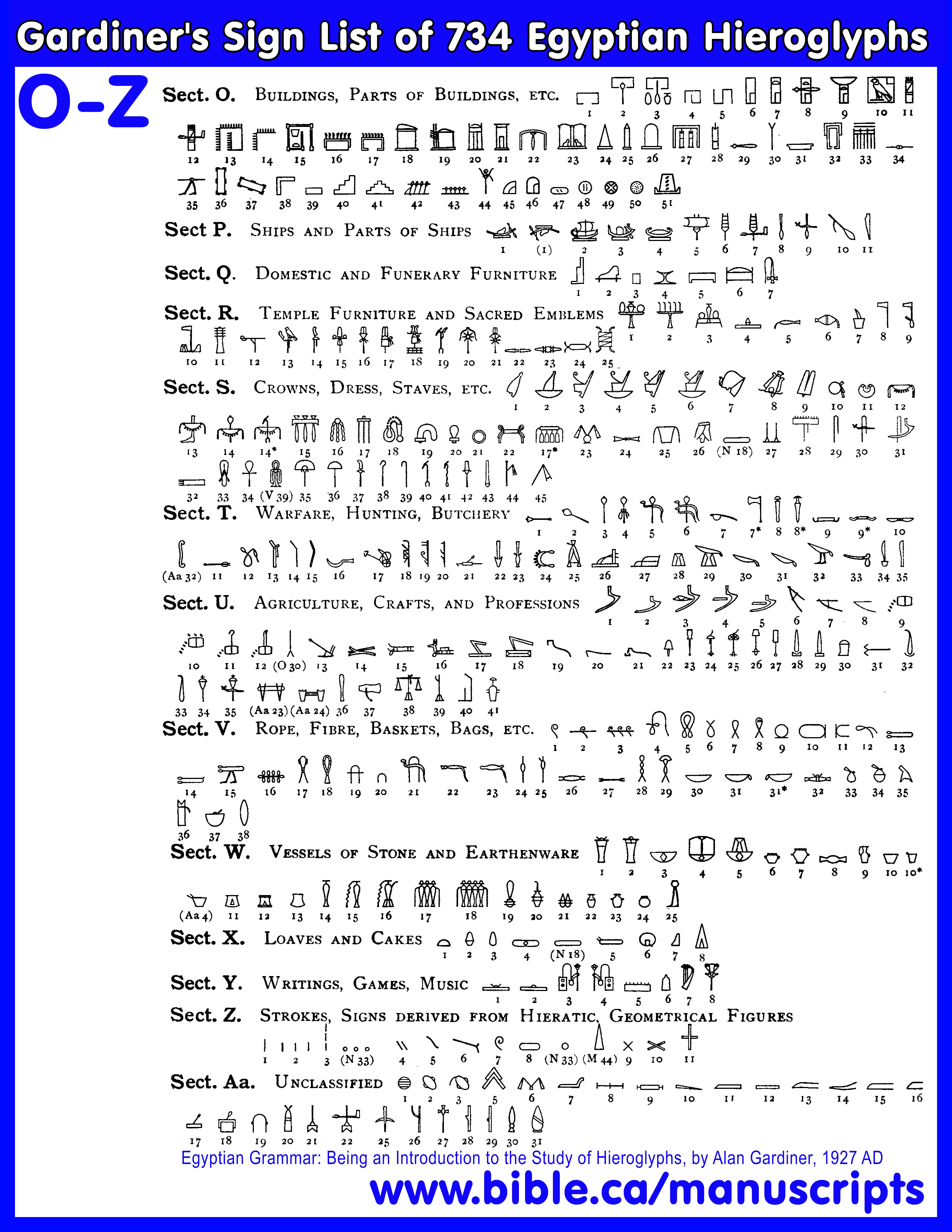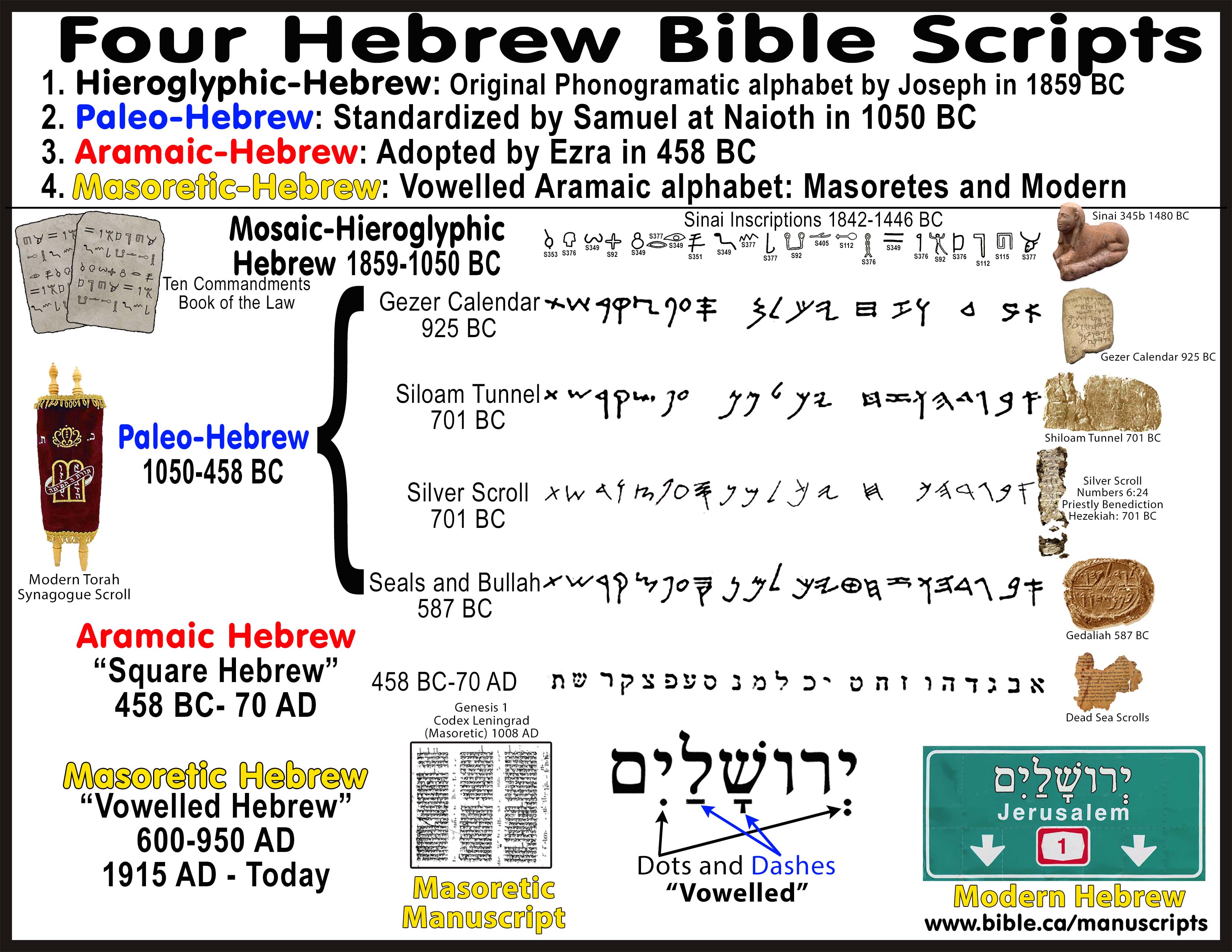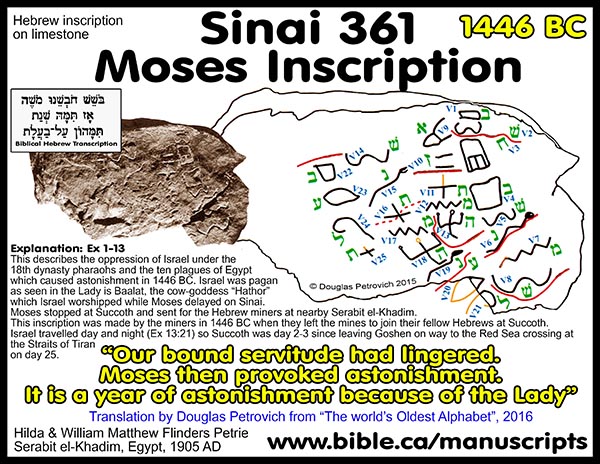The world’s first Moses inscription!
Hebrew was the world’s first alphabet
Historical Origin of the Alphabet
(And the Four Hebrew scripts)
|
Hebrew is the world’s Oldest Alphabet Hebrew is the Mother Alphabet of all other languages. English, Phoenician and Arabic are derived directly from Hebrew.
Between 1859-1842 BC, Joseph, Ephraim and Manasseh invented the world’s first alphabet shortly after they moved to Avaris also known as Tel el Dab’a.
Click to view the free, printable Hebrew, English translation chart. |
|
ANOTHER JEWISH NOBEL PRIZE: “For Literature” Nobel Prize to the Jews for inventing the first alphabet! |
|
|
Digging up Bible stories!
A collection of 16 previously untranslated ancient inscriptions lay in museums for 100 years but have now proven that Hebrew is the very first Alphabet in earth history from which all other alphabets, including English, Latin and Arabic, are derived. Dr. Doug Petrovitch has falsified the theory that Phoenician was the first alphabet but instead that Phoenician was derived directly from Hebrew! We know that Moses used this Hebrew Alphabet at Sinai in 1446 BC in the written Law of Moses. "What we read in the book, we find in the ground" |
|
|
Canadian Researcher, Dr. Doug Petrovitch is the first person in history to translate these 16 inscriptions and it all started when he realized they were in ancient Hebrew. This refutes the previous notion that Phoenician was the first alphabet and proves beyond doubt that Phoenician was derived directly from Hebrew which is in fact the true Proto-Canaanite alphabet. |
|
|
|
|
Hebrew: The mother Alphabet of all other Alphabets!
Script changes in Hebrew:
1. Mosaic-Hieroglyphic Hebrew script by Joseph in 1859 BC.
2. Paleo-Hebrew script by Samuel in 1050 BC
3. Aramaic-Hebrew “square” script by Ezra in 458 BC.
4. Masoretic-Hebrew “vowelled” script by Masoretes in 600 AD.
See full outline on Samuel’s and Ezra’s script changes in the bible manuscripts
See also: Four Hebrew scripts
Introduction:
1. Between 1859-1842 BC, Joseph, Ephraim and Manasseh invented the world’s first alphabet shortly after they moved to Avaris also known as Tel el Dab’a.
a. Remember that Joseph was a prophet, and God foresaw the need of His chosen people to have an alphabet for the Law of Moses God wrote down in 1446 BC at Mt. Sinai. Without an alphabet there would be no law of Moses.
b. Nothing that happens in history occurs by chance because God is in complete control.
c. While the Law Code of Hammurabi predates the Torah, it was written in cuneiform not an alphabet.
d. The Law of God needed a standardized alphabet to communicate the Law at Mt. Sinai.
e. It was invented by Joseph, Ephraim and Manasseh and became fully standardized into what we know today as “Mosaic Hebrew” (Paleo-Hebrew)
2. The origin of the alphabet has been a mystery for hundreds of years, until now.
a. 16 previously untranslated stone inscriptions from four different locations in Egypt, had been collecting dust in museum storage shelves until Dr. Douglas Petrovich translated them in 2016 AD from ancient Hebrew into English for the first time.
b. Previously, it was thought that Hebrew derived from some “Proto-Canaanite alphabet” or Phoenician, but this is now false.
c. Hebrew was the first and oldest alphabet on earth.
d.
All other alphabets including Phoenician, Latin, Arabic and English all
copied the original Hebrew alphabet and it is not hard to prove! Here is one of
the 16 inscriptions:
Click photo for details on Sinai 361

3. The Hebrews studied their unique spoken language and identified 22 different phonic sounds.
a. The Hebrews selected 22 of the 734 Egyptian hieroglyphic symbols as their alphabet “character set”, one for each of the 22 phonic sounds in Hebrew.
b. Although each of the 22 Egyptian hieroglyphs had an Egyptian word associated with it, the Hebrews ignored this and assigned a corresponding Hebrew word to represent the hieroglyph.
c. The first letter of each word represented that sound in their alphabet (acrophony). For example, the Egyptian word for cow is KA but the Hebrew word for cow is ALEPH. The Egyptian hieroglyph for cattle was a cow head with horns and is pronounced “KA”, but the Hebrew word for cattle was “ALEPH”. Since the first letter/sound was “A”, the ox head became the symbol for the Hebrew letter A.
4. Pictograms, Phonograms and Echograms prove Hebrew is the original language.
a. We can prove Hebrew is the original alphabet because it is the only alphabet in the world where the phonogram symbols correspond with all 22 letters of the alphabet. In all other languages, the acrophonic connection between the pictogram and the letter of the alphabet is broken. For example, a cow represents the letter A because it was the first letter for the Hebrew word for cow “aleph”. In English this phonic connection is lost because the first letter in the English word “cow” is C. Yet the English letter A, even today is a 180 degree rotated symbol of a cow head with horns.
b. Pictograms are pictures drawn to represent an object or an entire word or object. Chinese, Egyptian and the wedges, circles, ovals and triangles of Sumerian cuneiform.
c. Phonograms are pictures that represent a single sound that corresponds to FIRST sound of the object. (acrophony)
d. Echograms are the 22 characters of the Hebrew alphabet used in all non-Hebrew languages like English, Arabic and Latin where the original acrophonic connection is broken.
A. Pictograms: Chinese
1. Pictograms are pictures drawn to represent an object or an entire word or object. Chinese, Egyptian.
2. Chinese Pictograms are not an alphabet:
a. The Chinese language has no alphabet but uses one symbol/pictogram for an entire word.
b. It also combines several symbols to create one word.
c. In this amazing example, the Chinese word for a "large ship" is a composite of three symbols: Eight + Person + Boat = LARGE BOAT.
d.
This is obviously Noah's Ark unless you know of another ancient large
boat that had 8 people on it! There are over 100 other examples of where the
pictograms of the Chinese language actually tells the story of the first 11
chapters of Genesis.

B. Pictograms: Egyptian Hieroglyphs
1. Egyptian hieroglyphs were not an alphabet, but pictograms that represented entire words and ideas.
a. The fact that there were 734 different hieroglyphs clearly proves this was not an alphabet.
b. In 1927, Sir Alan Gardiner, categorized and recorded each of the 734 pictograms in his monumental book: “Egyptian Grammar: Being an Introduction to the Study of Hieroglyphs”.
c. Remember that the index A-Z does not correspond to the Egyptian alphabet, instead it was part of Gardiner’s alpha-numeric categorization system. (ie. A12, D53 etc.)
|
734 Egyptian Hieroglyphs |
||
|
Index |
Category |
Number |
|
A |
Man and his Occupations |
55 |
|
B |
Woman and her Occupations |
7 |
|
C |
Anthropomorphic Deities |
11 |
|
D |
Parts of the Human Body |
63 |
|
E |
Mammals |
34 |
|
F |
Parts of Mammals |
52 |
|
G |
Birds |
54 |
|
H |
Parts of Birds |
8 |
|
I |
Amphibious Animals, Reptiles, etc. |
15 |
|
K |
Fish and Parts of Fish |
6 |
|
L |
Invertebrates and Lesser Animals |
7 |
|
M |
Trees and Plants |
44 |
|
N |
Sky, Earth, Water |
42 |
|
O |
Buildings, Parts of Buildings, etc. |
51 |
|
P |
Ships and Parts of Ships |
11 |
|
Q |
Domestic and Funerary Furniture |
7 |
|
R |
Temple Furniture and Sacred Emblems |
25 |
|
S |
Crowns, Dress, Staves, etc. |
45 |
|
T |
Warfare, Hunting, Butchery |
35 |
|
U |
Agriculture, Crafts, and Professions |
41 |
|
V |
Rope, Fiber, Baskets, Bags, etc. |
38 |
|
W |
Vessels of Stone and Earthenware |
25 |
|
X |
Loaves and Cakes |
8 |
|
Y |
Writings, Games, Music |
8 |
|
Z |
Strokes |
11 |
|
AA |
Unclassified |
31 |
|
Total |
765 |
|
2. Egyptian Hieroglyphs are a logophonetic system of writing were used in three ways:
a. FIRST: In some cases, each Hieroglyphic symbol represented one, two or three of the 24 Egyptian language consonants as phonograms: It was this concept that the Hebrews borrowed from the Egyptians to create their first true phonographical alphabet in history.
b. SECOND: In other cases a hieroglyph represented an entire word.
c. THIRD: Sometimes hieroglyphs functioned as phonically silent “determinatives” in order to differentiate between, for example, a full or crescent moon or morning, noon or evening sun. A standard hieroglyph for the sun would be followed by a second determinative to indicate something about the sunlight itself. Likewise a determinative would follow the hieroglyph for the moon to indicate different phases of the moon. In this way determinatives were phonically silent but conveyed additional written information. Other times determinatives were needed to differentiate the meaning between two or three words that were spelled the same way in consonants of the same sound. For example, in English we have homonyms (same sound with different spelling: pear, pare, pair), and homographs (same spelling and sound with different meanings: Bat=flying mammal/baseball; Pitcher=jug/baseball) and heteronyms (same spelling with different sounds: ). Egyptian hieroglyphic determinates were used to differentiate this same kind of thing in English.
3. We are told that Joseph was 17 years old when he was sold into slavery and became fluent in reading, writing and speaking Egyptian language. This is clear from "They [Joseph’s brothers] did not know, however, that Joseph understood, for there was an interpreter between them." (Genesis 42:23)
a. Jacob and Josephs brothers moved to Egypt in 1876 BC and then moved to Goshen (Avaris) in 1859 BC.
b. It was between 1859-1842 BC in Goshen that the Joseph, Ephraim and Manasseh invented the world’s first alphabet shortly after moving to Avaris also known as Tel el Dab’a.
c. The Hebrews selected 22 of the Egyptian hieroglyphs and assigned their own unique “hebrewized” phonographic sound, one for each Egyptian symbol.
4. Here is Gardiner’s sign list of 734 Egyptian Hieroglyphs:
a. Although many of the Egyptian pictograms have a phonic sound associated with them, they did not use these pictograms to spell out words, as in modern English.
b. Each of the 22 letters of the modern Hebrew alphabet can be traced directly back to one of the 734 Egyptian Hieroglyphs.
c. From: “Egyptian Grammar: Being an Introduction to the Study of Hieroglyphs” by Alan Gardiner, 1927 AD
C. Phonograms: Hebrew as the proto-alphabet of all modern languages.
1. A phonogram is a word-picture of an object where the first letter of the spoken word corresponds to one of the letters of the alphabet.
a. While phonograms did exist in Egyptian Hieroglyphs, they were not used as an alphabet.
b. The Hebrews copied the concept of Egyptian phonograms to create, the world’s first alphabet for the spoken language of Hebrew.
c. We can prove English (and all other alphabets) is derived from Hebrew phonograms and NOT Egyptian phonograms, because each letter of the English alphabet “echos” the corresponding word-picture in Hebrew, NOT Egyptian.
d. For example, the English letter “A” is derived directly from the Egyptian pictograph of a “cow head” (F1) and has a “K” sound. As we can see the phonic correspondence is broken, even though the same pictograph is used. Yet in Hebrew the letter “A” corresponds to the Hebrew word for “cow/cattle”: Aleph. It is obvious then, that the sound of the English letter A was derived from Hebrew not Egyptian, even though all three languages use a cow to represent the letter A.
e. The Hebrews selected 22 of the 734 Egyptian hieroglyphic symbols as their alphabet “character set”, one for each of the 22 phonic sounds in Hebrew. Although each of the 22 Egyptian hieroglyphs had an Egyptian word associated with it, the Hebrews ignored this and assigned corresponding Hebrew word to represent the hieroglyph.
2. Between 1859-1842 BC, Joseph, Ephraim and Manasseh invented the world’s first alphabet shortly after they moved to Avaris also known as Tel el Dab’a.
a. Joseph was fluent in Egyptian language and hieroglyphs which had no alphabet.
b. Clearly Joseph noticed that some Egyptian hieroglyphs functioned as single sound phonograms and it was this basic Egyptian concept that became the foundation of the 22 letters in the Hebrew alphabet.
3. Joseph studied his native Hebrew spoken language and identified 22 different phonic sounds to which he simply assigned an Egyptian Hieroglyph, which functioned as a phonogram.
a. Joseph ignored how the Egyptians pronounced the 22 selected “word-picture” hieroglyphs and assigned a brand new and unique corresponding Hebrew sound to the pictogram and the Hebrew alphabet was born.
4. Examples:
a. For example, the Egyptian word for cow is KA but the Hebrew word for cow is ALEPH. The Egyptian hieroglyph for cattle was a cow head with horns and is pronounced “KA”, but the Hebrew word for cattle was “ALEPH”. Since the first letter/sound was “A”, the ox head became the symbol for the Hebrew letter A.
b. The Hebrew letter “B” was represented by a house (Hebrew: Beth) because the first sound in the Hebrew word for cow was “B”.
D. Echograms: English echoes the sounds of the Hebrew but the phonographic connection is broken
1. While Hebrew was the original proto-alphabet from which all other alphabets were derived, these second generation alphabets featured echograms:
a. An echogram is illustrated in the fact that the English letter “A” copied (echoed) the sound the Hebrew A, but the phonic connection to the original pictograph is lost.
b. The original pictograph underlying the Hebrew letter “A” is the word “Aleph” but the English word is “Cow”.
c. If English was the first alphabet the pictogram for a cow would represent the letter “C”.
d. This is how we can prove that Hebrew is the first and original alphabet from which all other alphabets are derived because the phonic sound of each letter corresponds with the pictogram ONLY IN HEBREW.
e. Hebrew is the only alphabet on earth that uses phonograms, all other alphabets use echograms borrowed from Hebrew.
2. If English used phonograms, we would select a picture whose first sound corresponds with letter of the alphabet it represents and the this is how you would spell CAT:
a. If the English letter “C” is represented by a picture of a Cow
b. If the English letter “A” is represented by a picture of a Apple
c. If the English letter “T” is represented by a picture of a Tree
d. We would spell CAT with a phonogram of a Cow + Apple + Tree.
3. English is derived directly from Hebrew:
a. English “A” borrowed the symbol of cow from Hebrew Aleph, in spite of the fact cow in English doesn’t even have any phonic connection with the letter A. The original Hebrew sound A is echoed into English but the phonographic connection is broken. The English letter A is an “echogram” of the Hebrew “phonogram” of a Cow.
b. The English letter for B was a picture of a Hebrew house (Beth) even though the English word for HOUSE doesn’t even have the sound B in it! The original Hebrew sound B is echoed into English but the photographic connection is broken. The letter B is an “echogram” of the Hebrew “phonogram” of a house.
c. There is no pictographic connection between any of the letters of the English alphabet and their phonic sound. Hebrew is the only language in the world where the symbol of each letter of the alphabet corresponds with its sound.
E. AMAZING MOSES OF THE EXODUS, INSCRIPTION:
Starting in 1906 AD, sixteen ancient Hebrew inscriptions from Egypt were discovered by Hilda & William Matthew Flinders Petrie at four sites: Serabit el-Khadim, Wadi Nasb, Wadi el-Hol and in Lahun. The Petrie’s knew it was a script but were unable to decode it so they lay collecting dust for 100 years until they were translated for the first time in 2015 by Dr. Doug Petrovich.
1. Dr. Doug Petrovich documented in his recent book, “Hebrew, the world’s oldest Alphabet” (2015 AD), that all modern alphabets are derived from the Hebrew Alphabet, including English. Petrovich was able to translate, for the first time, 16 ancient inscriptions that sat collecting dust in museum storehouses for over 100 years.
2. Sinai 361 is one example of sixteen of the oldest Hebrew inscriptions ever discovered and dates to 1446 BC.
a. TRANSLATION of Sinai 361: “Our bound servitude had lingered. Moses then provoked astonishment. It is the year of astonishment because of the Lady” Translation © Douglas Petrovich 2015
3. The contextual narrative and backdrop story of Sinai inscription 361:
a. This describes the oppression of Israel under the 18th dynasty pharaohs and the then plagues of Egypt which caused astonishment in 1446 BC.
b. Israel was pagan as seen in the Lady is Baalat, the cow-goddess “Hathor” which Israel worshipped while Moses delayed on Sinai.
c. This inscription was made when Moses stopped at Succoth and sent for the Hebrew workers at a nearby turquoise mine at Serabit el-Khadim.
4. Sinai 361 and the discovery of the first and most primitive Hebrew alphabet:
a. Remember that Sinai 361 is just one of 16 inscriptions translated by Petrovich.
b. While Sinai 361 dates to 1446 BC many of the other inscriptions date to between 1700-1842 BC.
c. Notice the form of the letters of the Hebrew alphabet closely resemble the Egyptian hieroglyphic pictograms.
d. We can be certain this is Hebrew and the proposed alphabet assignment by Petrovich is correct because they spell out actual known Hebrew words found in the Old Testament.
e.
These 16 inscriptions lay untranslated for over 100
years which not only evidence Hebrew as the proto-mother alphabet of
civilization, but also name 4 different Bible character unique to the book of
Genesis.

F. Hebrew to English alphabet and pronunciation chart:
1. And now we come to the brand new master chart on the origin of Hebrew alphabet.
a. The chart below is revolutionary in that it redefines 12 of the long accepted meanings behind each letter of the Hebrew alphabet.
b. For example, the meaning behind the pictogram for “S” was thought to represent the two front teeth, when in fact it represents a woman’s breasts.
|
12 New Hebrew Alphabet Letter Meanings |
||
|
Alphabet Letter |
Old previously accepted symbol and meaning |
New meaning confirmed by the 16 Sinai inscriptions |
|
G |
Camel (Gimel) |
Bend (Gahar) |
|
H |
Behold (Hey) |
Praise (Halal) |
|
Y |
Tent Nail (Vav) |
Support Column (Vaw) |
|
Z |
Plow, weapon (Zayin) |
Eye brows ie. Sweat (Zeah) |
|
Ch |
Fence (Heth) |
Hut (Haser) |
|
TH |
Spin, weave (Teth) |
Good (Tov) |
|
N |
Fish, sprout (Nun) |
Snake (Nahas) |
|
S |
Support, Staff (Samek) |
Hair (Sear) |
|
Ts |
Fish hook (Tzaddi) |
Sack (seror) |
|
Q |
Eye of needle (Quph) |
Spun fibre (Qur) |
|
SH |
Two front teeth (Shin) |
Woman’s breasts (Sadayim) |
|
T |
Cross (Tav) |
Male goat (Tayis) |
2. Notes on how to understand the “Biblical Hebrew to English Alphabet” chart below:
a. PICTOGRAMS: The left hand column has the original Egyptian Pictograms taken directly from Gardiner’s book on Sign Lists. The number in brackets (F1) is an alpha-numeric code that Gardiner assigned each of the 765 Egyptian pictographs. Beside this is a letter to indicate how each pictograph sounds in English. Notice that almost none of the Egyptian sounds correspond with any alphabet on earth.
b. PHONOGRAMS: The next three columns show the gradual transition in form from the Egyptian pictographs to the Mosaic Hebrew (Paleo-Hebrew) script. The Hebrew word whose first sound corresponds to the letter of the alphabet it represents with an English translation. (Aleph = cow). The centre column are actual tracings made from the Sinai inscriptions translated by Douglas Petrovich. The third column in this section to the right is the Paleo-Hebrew forms of each letter seen in the clay bulla from the period of the Babylonian Captivity of 605 BC. This form obviously transitioned from the original Egyptian pictograph sometime before the first five books of the Bible were written, perhaps during the 38 years Israel was at Kadesh Barnea (Petra). There are no extant manuscripts of any Bible text with Paleo-Hebrew, except for the Silver Scroll. It is entirely possible that the first five books of Moses were written in the original font style (Egyptian pictograms) as opposed to Mosaic Hebrew (paleo-Hebrew). At this point in history, we have no way of knowing when the Paleo-Hebrew replaced the original Egyptian Hieroglyph. The abbreviations “WH = Wadi el-Hol” and “Lah = Lahun”are archeological sites in Egypt where the inscriptions were found.
c. ECHOGRAMS: This column simply shows which letter from the English alphabet is under examination. Notice the sounds correspond 100% with Hebrew but not with Egyptian. This proves English was derived from Hebrew not Egyptian. It also proves Hebrew is the first alphabet on earth.
d. ARAMAIC, SQUARE, MASORETIC HEBREW: The final section in the chart to the right is superfluous to the origin of the alphabet. Around 550 BC, the Hebrews replaced the alphabet symbols they invented for the Aramaic alphabet, which ironically was directly descended from Hebrew. Here the pictographic forms no longer indicate their original origin that traces back to Egyptian Hieroglyphs. This is the script used from 550 BC down to the first century. The Hebrew language went extinct around 300 BC when Alexander the Great mass converted the world to Greek. The only exception was the Jerusalem high priest (Sadducees) who continued to speak Hebrew using the new Aramaic script. Aramaic was the default language of the Jews in the first century and Greek was the default language of the Jews living outside Judea. The stand issue Tanakh (Old Testament) in all synagogues in Israel and diaspora, was the Greek Septuagint, because nobody spoke Hebrew in the first century. The Masoretes were a small sect of Jews living at Zippori and Tiberias, who invented the dots and dashes of modern Hebrew. The oldest manuscript of the Old Testament in the world today, dates to about 1000 AD and was produced by the Masoretes which explains why it is called “the Masoretic Text.” The pronunciations of modern Hebrew are in the last column to the right.
Conclusion:
1. In the process of our enquiry about the origins of the Hebrew alphabet, we have uncovered the first ever, authentic inscription that names Moses of the Exodus!
2. Twenty of our English 26 alphabet letters are "echograms" that are directly descended from ancient Hebrew "phonograms", some almost identical and others rotated. Even more incredible is the fact that not only is English the universal language of today, it is the language that is closest to the original ancient Hebrew.
a. For example, our letter "A" in English is the same "ox head with horns rotated down" that traces back to the same symbol of an ox head invented in Egypt by Joseph and his sons.
b. We can be certain that the letter "A" in English derives from Hebrew because "A" is the echogram for an "Ox head with horns" which breaks the phonic connection between the symbol and the corresponding sound in English. If we had invented our own alphabet, the letter A (symbol of an Ox with horns) would replace our letter "O" and we would pronounce the alphabet symbol A like our O as in Ox and would spell it as "Ax" which is pronounced "OX".
c. Therefore, we can prove that our English "ecograms" are in fact derived and borrowed directly from the original Hebrew "phonographic" alphabet. Hebrew is the first alphabet on earth and archetypal grandparent of all other alphabets on earth. This is why we awarded Joseph, Ephraim and Manasseh the long overdue Nobel prize for Phonics and Literature.
3. With the translation of the 16 ancient Sinai inscriptions after collecting dust in museum storerooms, we now have firm proof, not only that Hebrew is the oldest and first alphabet, but evidence of the Hebrews in Egypt dating back to the time when Jacob entered Egypt!
4. GOD IS IN CONTROL OF EVERYTHING: It really should come as no surprise that God’s chosen people, the Hebrews, would invent the first alphabet, given the 39 books of the Old Testament were to be inspired in text form.
a. God’s law revealed at Mt. Sinai in 1446 BC required a written script.
b. When Israel entered Egypt, they had no written script.
c. God looked ahead and through Prophet Joseph and his sons Ephraim and Manasseh, invented the first alphabet in preparation for the written word of God.
5. In the same way, God through His providence, provided for the rise of Synagogues as a result of Antiochus II translating the word of God into Greek.
a. God looked ahead at the Babylonian Captivity and through Jeremiah prophesied the New Testament Law of Christ wherein the body of Christ, the church replaced the physical temple.
b. Weekly meetings in thousands of synagogues, each equipped with its own “Christian maker” (water baptistry- Mikveh) made the missionary journeys of the Apostle Paul very easy with a seamless transition from Temple, to synagogue to church.
c. Read detailed history of synagogues.
6.
We now know of four different Hebrew alphabetic scripts, thanks to the
translation skills of Dr. Doug Petrovich. This changes everything! BUY
HIS AMAZING BOOK.
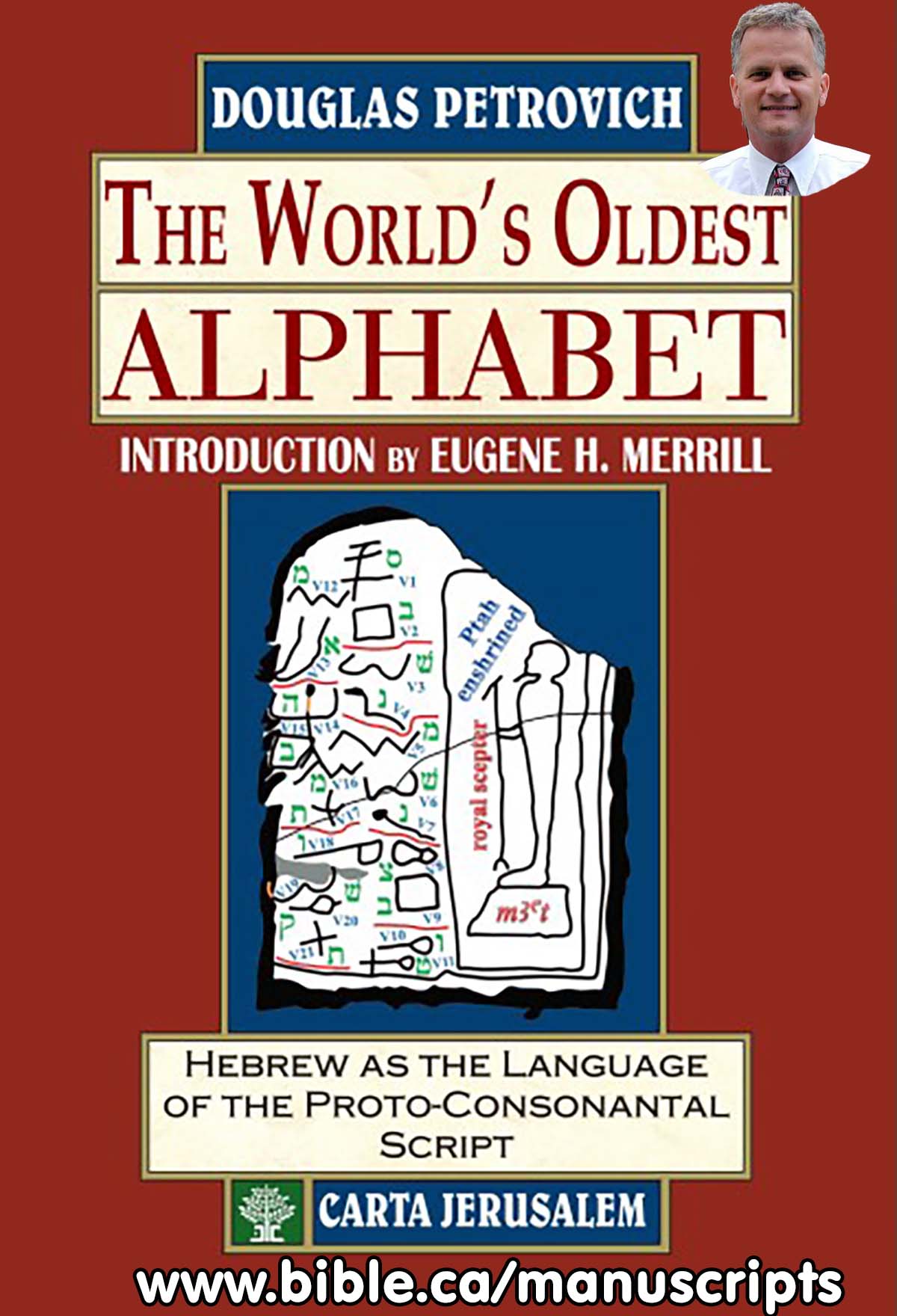
7. Four Hebrew Scripts: We see therefore, that the Hebrews have had four different written alphabet scripts:
a. Mosaic-Hieroglyphic Hebrew: 1859-1050 BC
b. Paleo-Hebrew: 1050 – 458 BC
c. Aramaic Hebrew (Square Hebrew): 458 – 70 AD
d. Masoretic Hebrew (Vowelled, modern) 600-1000; 1915-present.
8. Date of Script changes and the person who made the changes:
a. Mosaic-Hieroglyphic Hebrew script by invented by Joseph in 1859 BC.
b. Paleo-Hebrew script standardized by Samuel in 1050 BC
c. Aramaic-Hebrew “square” script adopted by Ezra in 458 BC.
d. Masoretic-Hebrew “vowelled” script invented by Masoretes in 600 AD.
9. See full outline on Samuel’s and Ezra’s script changes in the bible manuscripts
10. See also: Four Hebrew scripts
11.
See also:
|
Archeology of the Exodus |
||
|
|
Archeological evidence of the Exodus Survey of Archeological evidence from the 16 recently translated Sinai inscriptions, stone carvings, stele and papyri. |
|
By Steve Rudd: Contact the author for comments, input or corrections.
